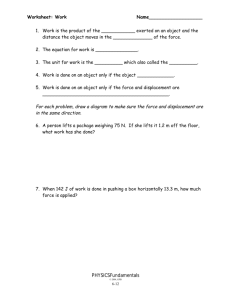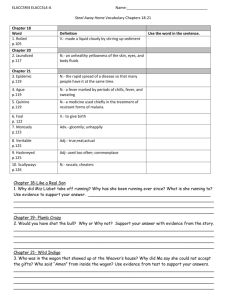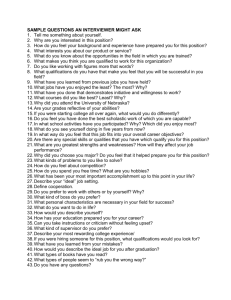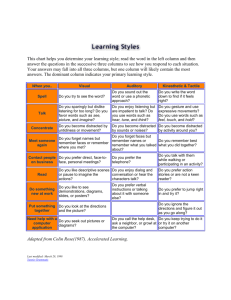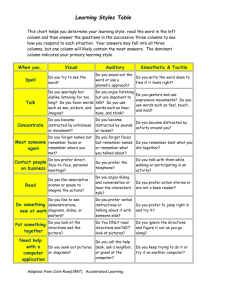Vector Addition of Forces using a Force Table and Bracket
advertisement
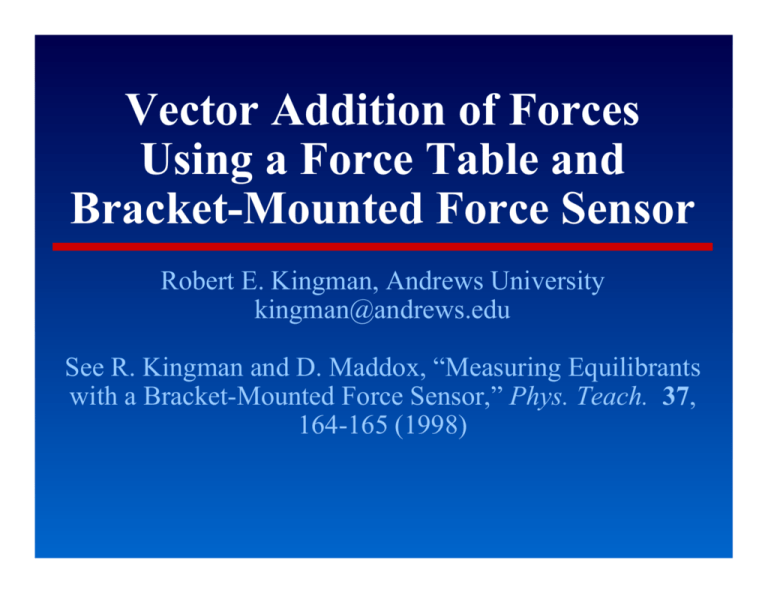
Vector Addition of Forces Using a Force Table and Bracket-Mounted Force Sensor Robert E. Kingman, Andrews University kingman@andrews.edu See R. Kingman and D. Maddox, “Measuring Equilibrants with a Bracket-Mounted Force Sensor,” Phys. Teach. 37, 164-165 (1998) Teaching Vector Addition with the Force Table and Force Sensor P Apparatus P Calibration P Live Example P Class Experiment P Student Response Force Table Top View Force Table Side View Spring Balances Example with Two Forces F1 = 1.96 N (weight of 200 gm) at 60E from positive x axis F2 = 2.94 N (weight of 300 gm) at 140E from the positive x axis F3 = 3.8 N at 290E from the positive x axis F1x = 1.96 N cos 60E = .980 N F1y = 1.96 sin 60 E = 1.697 N F2x = 2.94 cos 140E = -2.252 N F2y = 2.94 sin 140E = 1.890 N Fx = F1x + F2x = .980 N + (-2.252 N) = -1.272 N Fy = F1y + F2y = 1.697 N + 1.890 N = 3.587 N 2 = tan-1(Fy/Fx) = tan-1(3.587/-1.272) = -70.5E or -70.5E +180E = 109.5E, this last one is the direction of the sum. The direction of the balance force F3 = 3.8 N is 290E from the positive axis so a vector in the opposite direction acts at an angle of 290E- 180E = 110E. Example on Force Table Reference direction 22 21 23 Exam Instructions P Place in the blank to the left the letter corresponding to the best answer for each question and indicate the degree of your confidence in your answer on a scale of 1 for a “wild guess” to 5 for “very confident” by drawing a circle around the number. Answer all seven questions. Question 1 P 1. For the force shown in figure 1 which one of the indicated possibilities is the east-west component of the force? Select the one with the proper length and direction. north P P A. A east P B. B P C. C P D. D P E. E A P B P answer ______ P C P confidence 1 2 3 4 5 D P E Question 2 2. A force of 50 N acts in the direction of 36.9E E of S. Which of the following arrows best represents this force? B A. B. C. D. E. A B C D E A C E north answer ______ confidence 1 2 3 4 5 D east Question 3 P 3. A boy and a girl each pull on their red wagon. The boy pulls eastward with a force of 60 N and the girl pulls northward with a force of 80 N. Which of the following diagrams best represents the net force that the two of them exert on the wagon? P B P A. A P B. B P C. C A C P D. D P E. E D P north P answer ______ P east E P confidence 1 2 3 4 5 P Question 4 P 4. A boy and a girl each pull on their red wagon. The boy pulls with a force of 100 N in the direction of 30E S of E and the girl pulls with a force of 140 N in the direction of 60E N of W. Which of the following diagrams best represents the net force that the two of them exert on the wagon? The bold arrow is the net force. P P A. A and B P B. B A P C. C and D B P D. D P E. C P P answer ______ P C D P confidence 1 2 3 4 5 P Question 5 P 5. Calculate the magnitude and direction of the net force that the boy and girl exert together on the red wagon in question 4. Do this by finding the east-west and north-south components and adding them. Show the details of your solution for this question. P P Magnitude of net force _____________ P P confidence 1 2 3 4 5 P P P P Direction of net force ____________ P P confidence 1 2 3 4 5 P PREFER SPRING BALANCE Average Final Post Test Question 5 Average 35/9 = 3.89 I would prefer the spring balance. Basically, the steps were easier and they took less time to do, while I believe still maintaining accuracy I’m not really sure. The force table generated more accurate answers but I seemed to have trouble knowing what to do. The spring balances, while more crude and not as accurate seemed to go smoother for me. I’m not sure if this is because it was our second time doing the experiment or if one was easier than the other. The spring balance. I could visualize what was going on a lot easier with the spring balance. To be able to visually plot to scale the vectors, helped me understand things better. The force table was too much computer working and I believe that threw me off. And components with the force table was a nightmare. Spring balance. It was easier to understand. PREFER SPRING BALANCE (continued) Spring balance. It just seemed to make more sense. I guess drawing it on paper was better for me. As a 1st time Physics student I think visually I got the idea better when we did the balances. The force table was so easy to use with the computer that I didn’t spend much time thinking about what it was I was actually completing. I would use the spring balances. They are hands on. I feel like I’m in a learning environment rather than being spoon-fed by technology. You can actually see that there are angles to be drawn. I like being able to draw the pictures. PREFER FORCE TABLE Average Final Post Test Question 5 Average 72/11 = 6.55 Force table. More accurately readable and understandable data. The force table. I think there is less room for error because you are able to use the computer and you don’t have to transfer your vectors from one sheet of paper to another (lots of room for error) like you do when you take the readings with the spring method. Our relative error doubled when we went from force table to spring. I would do it with the force table because the experiment helped me visualize the concept better. Force table. It was easier to get the angles. The force table because it was easier and I understood how it worked better. The force table, because it’s easier than having to draw your vectors in, even though it’s the same idea. PREFER FORCE TABLE (continued) Table seems easier to do a 2nd time. I would definitely prefer the force table. It was a lot easier to use and our data came out 10 times more exact. We had a very high percentage error when using the spring balances. Just because the force table looks more hi-tech, and I think that it is more accurate since the force table has a full protractor on it. It is more accurate to use the force table than the spring balances where we draw the angles out ourselves. Either way is okay - it was easier to work off the force table. Things stayed a little more stable there. (Prefer? = force table) Questions 1-4 Comparison SB Lab SB Lab 9 9 4 4 3 3 2 Q1_4G1 1 0 2 Q1_4G2 1 PretMean FPostMean SPostMean 0 PretMean FPostMean SPostMean Question 5 Comparison SB Lab SB Lab 9 9 12 10 10 8 8 6 6 Q5G1 Q5G2 4 4 2 2 0 PretMean FPostMean SPostMean 0 PretMean FPostMean SPostMean Questions 1-5 Confidence Comparison SB Lab SB Lab 9 9 6 10 5 8 4 6 3 Q5G2 CQ1_5G1 4 2 2 1 0 0 PretMean FPostMeanSPostMean PretMean FPostMean SPostMean Conclusions P The Force Table experiment yields error results of about 1% as compared to about 10% for the Spring Balance experiment. P Some beginning physics students find the Spring Balance experiment more intuitive and less threatening. P Nearly half of the students preferred the Spring Balance. P The data suggests that the Force Table experiment was more effective in teaching vector addition concepts. P Student remarks indicate little recognition of the experiment as a test of the way in which forces combine. P The Force Table experiment provides a precise and easy way to test the rules of vector addition but students need to understand the rules before doing the experiment.

